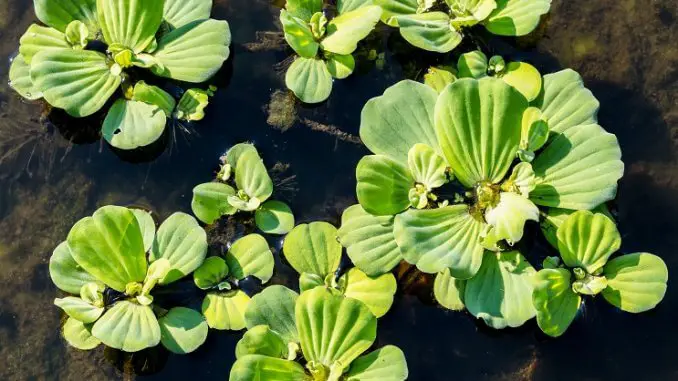
Water lettuce is a freshwater plant species used as a floating plant in aquariums. This plant has thick, soft, light green to gray-green leaves that form a rose shape.
Water lettuce is a vigorous grower and has broad water condition tolerances, making it a good low-hassle plant for home tanks. However, because the plant grows so fast, it quickly covers the surface of the water and decreases the water’s oxygen content, potentially killing the tank’s inhabitants.
TABLE OF CONTENTS
Water Lettuce Facts & Overview
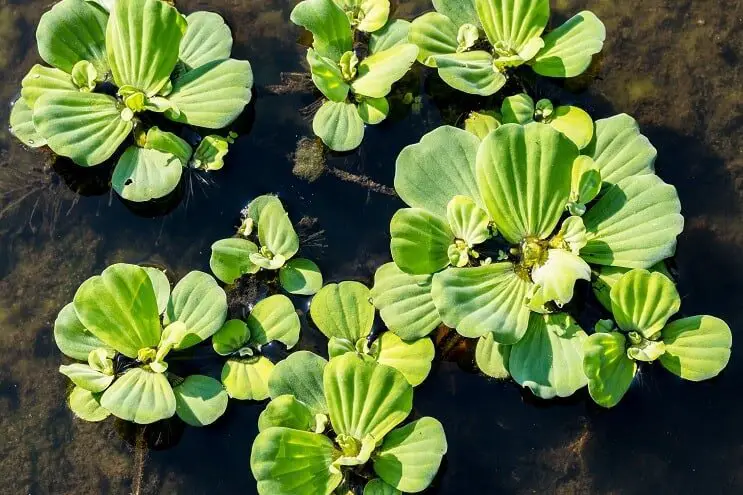
| Scientific name: | Pistia stratiotes |
| Common names | Water lettuce, water cabbage, river lettuce, shell flower, water bonnet, pond lettuce |
| Origin: | South America, Africa |
| Height: | 4 inches |
| Growth rate: | Fast |
| Color: | Light green, gray-green |
| Aquarium placement: | Floating |
| Water type: | Freshwater |
| Temperature: | 72–86°F (22–30°C) |
| pH: | 6.5–7.5 |
Origin & Distribution
Water lettuce is thought to have originated in South America and Africa, and today the plant is considered an invasive species found on all continents apart from Antarctica.
Water lettuce inhabits tropical and subtropical reservoirs, ponds, slow-flowing streams, and lakes. The plant is highly tolerant of a variety of water conditions in the wild and has been known to survive in water as cold as 39°F.
The hardiness of water lettuce makes it a popular choice as a low-maintenance aquarium plant.
Availability
Water lettuce is cheap and commonly available. You can find the plant in local pet stores, online aquatics stores, and marketplaces like eBay. The average cost of water lettuce is $4 per plant.
To ensure you’re buying a high-quality plant, buy from reputable online stores, such as:
Water lettuce is forbidden in some states due to its invasive, weed-like growth. The plant is prohibited in Mississippi, Florida, Louisiana, Alabama, California, Wisconsin, and Texas, and is considered a noxious weed in Delaware and South Carolina.
Check the legality of buying water lettuce in your state to ensure you don’t break any rules.
Appearance & Size
Water lettuce is a free-floating plant with bright green to blue-green velvety, ribbed leaves. The plant has a rose-like appearance from above, with a cluster of scalloped leaves that float on the surface of the water. Beneath the leaves are free-hanging, dark green feathery roots.
To reproduce vegetatively, water lettuce grows runners with copies of itself, spreading across the water’s surface. The average width of water lettuce is 6 inches, but in the right conditions, it grows up to 20 inches wide.
The plant is fast-growing, and can completely cover the surface of an aquarium in a matter of months.
Young water lettuce is smaller and brighter than an old plant. There are several common water lettuce variants and subspecies:
- Ruffled water lettuce: Has clusters of small wavy leaves, and is smaller than common water lettuce plants.
- Jurassic water lettuce: Has large flared leaves, and is bigger than common water lettuce plants.
- Dwarf water lettuce: A smaller version of common water lettuce, growing to about 4 inches in width.
Benefits of Water Lettuce in Aquariums
Water lettuce adds vibrant, attractive greenery to a pond or aquarium, oxygenates the water, and is highly efficient at removing toxic nitrogen and preventing aggressive algae growth.
The plant provides shaded areas for fish that prefer low sunlight, and some fish lay eggs on the lower leaves and roots of the plant.
Compatible Tank Mates
Most fish pair well with water lettuce, although large or herbivorous fish are known to damage or eat the leaves, stunting the plant’s growth.
Avoid housing water lettuce in tanks with large, fast-moving fish, like cichlids, that could rip the plant’s roots, and keep the plant away from fish species that eat plants, such as goldfish.
You can safely add water lettuce to a tank containing:
- Freshwater crabs
- Loaches
- Crayfish
- Snails, like mystery snails, ramshorn snails, and nerite snails
- Shrimp, like cherry shrimp, ghost shrimp, and Amano shrimp
- Guppies
- Catfish
- Plecos
Water lettuce can be planted alongside other plants, but the species is known to grow over the surface of the water, which could prevent plants growing beneath the surface from getting enough light.
Water Lettuce Conditions & Requirements
Growing water lettuce is easy because the plant is tolerant of a range of water temperatures and conditions.
In the wild, water lettuce thrives in tropical and subtropical waters with a slow flow rate. Provide a similar environment in the tank, with warm, moderately hard water and medium-bright light. Water lettuce grows on the water’s surface, so the choice of substrate for this plant is unimportant.
Tank Requirements
Water lettuce’s wild habitat is the slow-moving waters of ponds, lakes, canals, and drainage ditches, in water between 0 and 30 feet deep. To recreate this environment in a private pond or home aquarium, follow these steps:
- Ensure the water parameters are correct. Moderately hard water with a temperature of 72–86°F and a pH of 6.5–7.5 is best.
- Check that your aquarium lighting is suitable. T8 or T5 grow bulbs providing full-spectrum, medium-to-bright light are ideal, but lighting should be lower than usual when first introducing the plants to the tank.
- Place an aquarium cover on the tank to provide a moist environment, preventing the leaves from drying out and decreasing their likelihood of being burned by the light.
- Install a floating dam to protect the water lettuce and prevent the plant from becoming submerged if your tank has a fast-flowing filter.
Tank Conditions
The ideal tank conditions for water lettuce are:
| Water type: | Slightly acidic, moderately hard freshwater |
| Tank size: | Minimum 10 gallons |
| Water temperature: | 72–86°F |
| Required substrate: | Any — substrate choice doesn’t affect plant growth |
| Tank placement: | Floating |
| Acidity: | 6.5–7.5 pH |
| Water hardness: | 3–8 dGH |
| Light type & strength: | Moderate to high aquarium lighting |
| Hours of light: | Around 12 hours |
| Water heater: | Preferable, to provide a tropical or subtropical climate |
Water lettuce thrives in a spectrum of water conditions. As long as the basic water parameters are maintained, with high humidity levels above the water, the plant should grow healthily.
Tank Placement & Aquascaping

Water lettuce is a floating plant that grows on the surface of the water, with stems that grow up to 6 inches. The plant doesn’t need to be rooted in soil or sand to grow.
Plant water lettuce by itself or in a group of several of the same species on one side of the tank. The plant grows quickly, so keeping it within one section of the tank will prevent it from blocking light completely.
Introducing Water Lettuce in the Aquarium
To successfully introduce water lettuce in the aquarium, follow these steps:
- Place the plant in a quarantine tank with moderate lighting. Water lettuce is usually grown in low-light conditions in nurseries, so the plants should be gradually acclimatized to moderate light.
- Leave the plant for up to four weeks and carry out routine water changes. Add plant water conditioner to the tank every day to remove pesticides and other residues.
- Remove the plant from the quarantine tank after four weeks and transfer it to the main tank, placing it on the surface of the water. The main tank’s conditions should be identical to the quarantine tank’s conditions to reduce the stress on the plant during the transition period.
- Observe the plant for several weeks after adding it to the main tank. Stressed plants may shed their roots in the first few weeks, but the roots should grow back once the plant has acclimatized to its new environment.
Care & Growing Guide
Water lettuce is easy to care for because it’s hardy and tolerant to most water conditions. The biggest challenge of growing water lettuce is keeping it under control because of how rapidly it grows.
Nutrition
Water lettuce doesn’t need any nutrients or chemicals to grow, although fertilizer can be used to achieve larger-than-normal rosettes. Adding a small amount of potassium nitrate to the water also helps the plant to thrive.
To fertilize water lettuce, remove the plant from the tank and place it in a tub containing liquid fertilizer. Don’t add fertilizer straight to the tank because this could harm or kill the other living things in the aquarium. Fertilize the plant once a month, or when you notice the leaves turning yellow or brown, which suggests a lack of nutrients.
Maintenance
Water lettuce isn’t prone to many specific problems or diseases in the aquarium.
Yellow or brown leaves are a sign that your water lettuce is getting too much direct light, so reduce lighting if you notice this change in your plant. House the plant with fish species that avoid plants, because this stunts the plant’s growth and often kills the plant.
Water lettuce grows quickly, and the plant should be pruned on a weekly basis to prevent overgrowth. To prune water lettuce, use your thumb and forefinger to pinch off the plantlets (the tiny leaves forming at the center of the plant). If the roots are growing too long, use a pair of scissors to cut them, leaving at least 4 inches behind.
Overgrown water lettuce reduces surface air exchange, starving the tank’s inhabitants of oxygen. Prevent this by regularly pruning the plant or installing a good bubbler to oxygenate the water.
Propagation
Water lettuce propagates on its own, so you don’t need to do anything to encourage reproduction.
The plant propagates sexually in the wild when the male and female flowers are fertilized. In the home aquarium, it propagates asexually, producing runners (horizontal roots or stems) that grow beneath the water and sprout new plants along their length.
When water lettuce propagates, you’ll notice small plants appearing next to the main plant. If these plants are allowed to grow, they’ll grow as big as the main plant.
Should You Get a Water Lettuce for Your Aquarium?
Water lettuce is a vibrant, hardy plant that doesn’t need much input to grow healthily.
You should get a water lettuce plant if you have a tropical freshwater tank containing fish and invertebrates that enjoy low-light environments, and you’re prepared to prune the plant to prevent overgrowth.
Don’t get water lettuce if your tank contains fish that could damage or eat the plant, or if growing water lettuce is illegal in your state.
Despite its fast, weed-like growth rate and illegal status in some states, water lettuce keeps tanks clean and stable by oxygenating the water and removing excess nitrate.

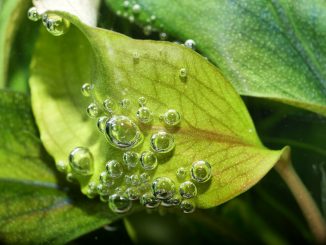
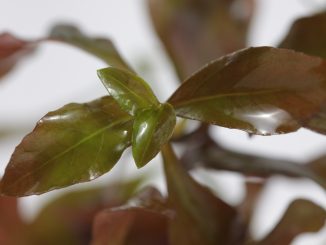
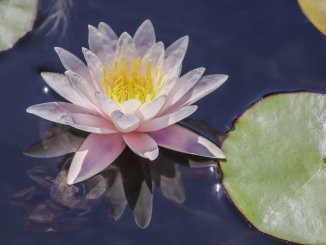
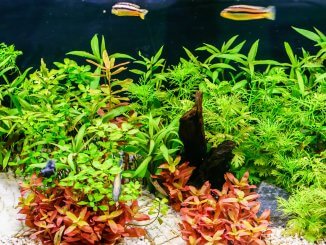
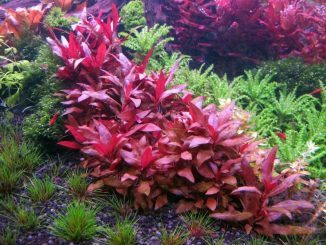

Be the first to comment